| Author | Affiliation |
|---|---|
| Federico E. Vaca, MD, MPH | University of California, Irvine Medical Center, Department of Emergency Medicine Center for Trauma and Injury Prevention Research, Orange, CA |
| Craig L. Anderson, MPH, PhD | University of California, Irvine Medical Center, Department of Emergency Medicine Center for Trauma and Injury Prevention Research, Orange, CA |
| Harold Herrera | Dynamic Science, Inc., Anaheim, CA |
| Chirag Patel, MD | University of California, Irvine Medical Center, Department of Surgery, Division of Trauma/Critical Care, Orange, CA |
| Eric F. Silman, MD | University of California, Irvine Medical Center, Department of Emergency Medicine Center for Trauma and Injury Prevention Research, Orange, CA |
| Rhian DeGuzman | University of California, Irvine Medical Center, Department of Emergency Medicine Center for Trauma and Injury Prevention Research, Orange, CA |
| Shadi Lahham, MS | University of California, Irvine Medical Center, Department of Emergency Medicine Center for Trauma and Injury Prevention Research, Orange, CA |
| Vanessa Kohl | University of California, Irvine Medical Center, Department of Emergency Medicine Center for Trauma and Injury Prevention Research, Orange, CA |
ABSTRACT
Introduction:
The accuracy of pre-hospital crash scene details and crash victim assessment has important implications for initial trauma care assessment and management. Similarly, it is known to influence physician perception of crash victim injury severity. The goal of this feasibility study was to examine paramedic accuracy in predicting crash victim injury profile, disability outcome at hospital discharge, and reporting vehicle damage with other crash variables.
Methods:
This prospective case series study was undertaken at a Southern California, Level I trauma center certified by the American College of Surgeons. Paramedics transporting crash injured motor vehicle occupants to our emergency department (ED)/trauma center were surveyed. We abstracted ED and in-patient records of injured vehicle occupants. Vehicle and crash scene data were obtained from a professional crash reconstruction, which included the assessment of deformation, crash forces, change in velocity, and the source of each injury.
Results:
We used survey, injury, and crash reconstruction data from 22 collision cases in the final analysis. The median Injury Severity Score (ISS) was five (range 1–24). No enrolled patients died, and none were severely disabled at the time of discharge from the hospital. The paramedic crash injury severity predictions were sensitive for an Abbreviated Injury Scale (AIS) of 2–4. Paramedics often agreed with the crash reconstruction on restraint use, ejection, and other fatalities at the scene, and had lower levels of agreement for front airbag deployment, steering wheel damage, and window/windshield impact. Paramedics had 80% accuracy in predicting any disability at the time of hospital discharge.
Conclusion:
Paramedic prediction of injury profile was sensitive, and prediction of disability outcome at discharge was accurate when compared to discharge diagnosis. Their reporting of vehicle specific crash variables was less accurate. Further study should be undertaken to assess the benefits of crash biomechanics education for paramedics and other pre-hospital care providers.
INTRODUCTION
Pre-hospital information gathered at the scene of a motor vehicle crash can yield important clues to life-threatening injuries. The crash mechanism (single vehicle, multivehicle), crash geometry (frontal, side-impact, rollover), vehicle speed, restraint use, and the extent of occupant space intrusion can all influence the likelihood of serious injury.1 As out-of-hospital personnel incorporate their initial in-field victim assessment along with crash scene details, crash victim injury profiles emerge and are relayed to definitive trauma care providers. The accuracy of crash scene details and crash victim assessment have important implications for initial in-hospital acute care assessment and management, as well as physician perception of crash injury severity.2 To date, out-of-hospital personnel accuracy of crash injury profiles and crash victim outcome prediction has had limited evaluation.
Crash reconstruction combines technical knowledge of motor vehicle crash characteristics, thorough measurement of vehicle deformation, and mathematic analysis of crash dynamics to determine the sequence of crash events, the speeds and forces involved, and the specific sources of each injury. The forces acting on a vehicle are typically summarized by Delta V, the change in velocity as a result of the impact, which is well correlated with injury to occupants.3 Because it uses all the available evidence from crash reports, inspection and measurement of the vehicle and medical records, it represents a true gold standard for crash variables.4 The goals of this study are to determine the feasibility of crash injury research in a clinical setting and to examine paramedic accuracy in predicting crash victim injury profile, disability outcome, and reporting vehicle damage with other crash variables.
METHODS
Study Design
We used a convenience sample of paramedics caring for crash-injured victims. The data collected included questionnaires from paramedics, abstraction of emergency department (ED) and in-patient hospital records, as well as vehicle and crash scene data from professional crash investigation. The study protocol was reviewed and approved by the local institutional review board.
Study Setting and Population
The study was undertaken at a Level I trauma center certified by the American College of Surgeons. The ED/trauma center is located in Southern California and in 2002 had an ED census of 40,000 and 1,800 trauma activations.
Study Protocol
Paramedics transporting crash-injured motor vehicle occupants to our ED between the hours of 8am–12am daily from November 2001 to August 2002 were eligible for participation in the study. Immediately after transferring the patient to the trauma team, the paramedic who provided verbal report to the trauma team captain was approached by a trained research assistant, who introduced the study and obtained verbal consent for participation. The paramedic completed an anonymous questionnaire that recorded their assessment of the condition of the patient and the vehicle occupied by the patient. The paramedic was asked to identify restraint use, occupant location, occupant ejection, other fatalities, passenger compartment space intrusion near occupant, crash type, airbag deployment, steering wheel damage, and window/windshield impact. They were also asked to predict, when applicable, the severity of the patient’s injuries by placing a mark on a 100 mm visual analog scale (VAS) anchored by the words “mild” and “severe,” for each of eight body areas (head, neck, chest, back, abdomen, pelvis, upper extremities, and lower extremities). The VAS was used for simplicity in assessing the predicted level of injury without reference to a standard coding system. Finally, paramedics were asked to predict the crash victim’s disability outcome at the time of discharge from the hospital from eight categories corresponding to disability scores: level 0 – living with no disability; levels 1–6 for increasing levels of disability, and level 9 for death.5
When the crash victim was deemed clinically stable by members of the trauma team, he was approached by a study team member, apprised of his role in the study, and consented by the study team for chart review and separately for vehicle crash investigation. At the conclusion of the patient’s course of hospital treatment, his charts were reviewed and relevant data were abstracted from ED/trauma care records, radiological reports, surgical reports, and discharge summary. A trauma surgeon reviewed all cases, ranked all injuries on an Abbreviated Injury Scale (AIS) from 1 (minor injuries) to 6 (unsurvivable), computed Injury Severity Scores (ISS), and assigned disability scores based on the patient’s status at discharge using the same scale by the paramedic.6,7
Following initial patient consent and without knowledge of paramedic prediction, the senior crash investigator performed a complete vehicle and crash scene investigation. This industry-standard evaluation consisted of detailed vehicle measurement and photography, as well as physical reconstruction of the crash. Data were gathered on all crash variables previously evaluated by paramedic on the anonymous questionnaire. The investigator assessed restraint use by examining seat belts for scoring due to movement of the belt through metal components during crash loading. Ejection was assessed from the crash report and from injuries consistent with impacts with objects in the environment. Other fatalities at the scene were assessed from the police crash report. Intrusion was measured by the deformation of the interior surfaces of the passenger compartment near the occupant and defined as positive if 3cm or more. The investigator assessed airbag deployment by inspecting the airbag. Steering wheel damage and window/windshield impact were assessed by inspecting these parts of the vehicle for damage and traces of blood or tissue at impact points. After completion of crashed vehicle investigation, we matched each diagnosed injury to specific damage in the vehicle and evidence of bodily contact.
Data Analysis
Data from paramedic questionnaires were divided into three sections: crash variables, VAS and AIS injury assessments, and disability outcome predictions. Paramedic-reported crash variables were compared with the corresponding variables from the formal crash investigation report, which was considered the gold standard.
Paramedic responses of “unknown” for variables known upon crash investigation were counted as incorrect. With the exception of airbag deployment, a response of “not applicable” was interpreted as “no.” Sensitivity and specificity were calculated for all yes/no variables and for the disability scale. We calculated exact 95% confidence intervals using the binomial distribution (Stata 9.2, StataCorp, College Station, TX). We quantified injury severity predictions by measuring the distance in mm to each mark from the left side of the 100 mm horizontal line. No mark was interpreted as zero mm.
Crash case example
A 59-year-old female with a history of Addison’s Disease and hypothyroidism was the driver of a small four-door sedan that collided with a large sedan traveling in the opposite direction. The crash occurred as the driver of the small sedan was attempting to make a left turn. At impact, the Delta V for the small sedan was estimated to be 31.7 km/h and 31.1 km/h for the large sedan.
Figure 1 shows the amount of crush deformation of the small sedan with crash investigation equipment. These measurements were used to calculate the crash forces at the time of impact and the Delta V. Seatbelt use by the small sedan driver was evident by the neck and chest wall contusion (seat belt sign) noted in Figure 2. The driver of the small sedan suffered a large full-thickness laceration of the left lower extremity (Figure 3) found to be due to impact with the after-market alarm LED shown in Figure 4. The role of this object as a significant source of injury was determined only through the comparison of crash reconstruction with clinical findings. Formal reconstruction of the crash demonstrated that on impact the driver translated forward and slightly underneath the seatbelt (submarine), allowing for pelvic contact with the instrument panel resulting in sacral ala and pubic rami fractures (Figure 5). Once again, the true mechanism and source of these significant fractures could only be determined through an understanding of the crash kinematics offered by crash reconstruction.
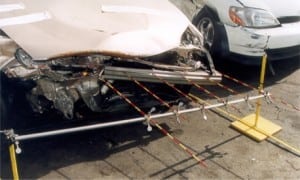
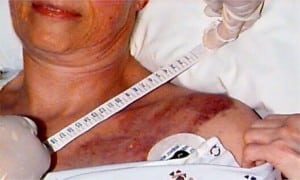
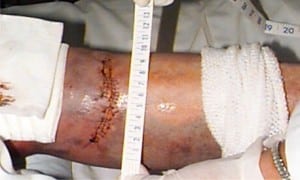
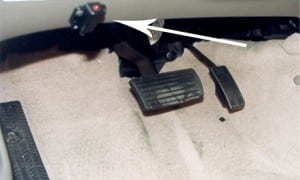
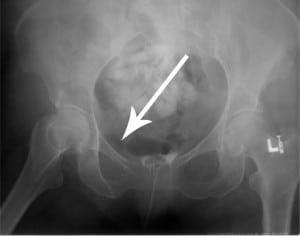
RESULTS
We collected information from paramedics regarding 129 eligible crash victims. Fifty-six crash injured victims declined or were unable to provide consent; 22 cases were excluded because the vehicle had been sold for salvage before the crash investigator could gain access to it. Twenty-nine cases had incomplete investigation. Data from the remaining 22 cases were used in the analysis.
The median ISS was five (range 1–24). At the time of discharge from the hospital, none of enrolled patients died and none were severely disabled; 14 had no disability, six had a minor disability (disability score=1), and two had insufficient data on disability at discharge to assign a score. With the exception of one collision with a wall and one collision with a tree, all other cases involved collisions between two or more vehicles.
The frequency of agreement for seven yes/no crash variables are presented in Table 1. Paramedics most often agreed with the crash reconstruction on restraint use, ejection, and other fatalities at the scene, and had somewhat lower levels of agreement for front airbag deployment, steering wheel damage, and window/windshield impact. Paramedics reported space intrusion near the occupant for 19 of 22 cases, but the crash reconstruction identified occupant space intrusion in only half the cases. In addition, paramedics agreed with crash reconstruction on the specific seating location for 20 of 22 cases (91%, 95% CI 71–99%) and on the collision type for nine of 22 cases (41%, 95% CI 21–64%).
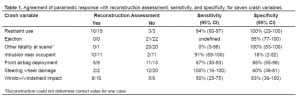
Paramedic injury severity predictions
Twenty injured crash victims had paramedic injury severity predictions for each of eight body regions. (For two cases, the paramedics described the injuries verbally and did not use the VAS.) Although the severity predictions were moderately related to the AIS scores (r=0.52), 18 of 20 of the predictions for AIS score of 2–4 (moderate to severe injuries) were 25 to 100 mm (Table 2). The two injuries of AIS 2–4 that had VAS predictions less than 25mm, were an abdominal injury (splenic laceration) and a pelvic injury (sacral and pubic rami fractures).
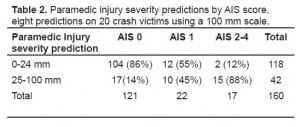
Outcome – Disability Results
Paramedics had 80% accuracy in predicting any disability at the time of hospital discharge as shown in Table 3. Paramedics overestimated disability in three cases and underestimated disability in three other cases.
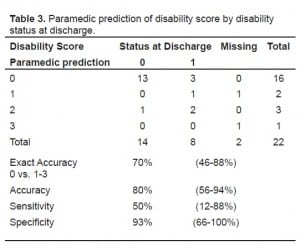
DISCUSSION
We were able to obtain crash reconstruction data on approximately one of six crashes of eligible injured motor vehicle occupants. The largest number of case exclusions was because injured crash victims, including the most severely injured subjects, did not or could not consent to data collection. Problems in obtaining consent were the most important barrier to the feasibility of performing crash injury research in this study.
This study compared paramedic predictions of injury profile and disability outcome to diagnosis at discharge. It also compared paramedic report of crash variables, based on their observations at the crash scene, to professional crash reconstruction, the highest quality of crash data. The crash reconstruction data represent a true gold standard for valid assessment of the accuracy of paramedic observations.
Crash variables are important indicators of severity and may suggest body regions for more intensive diagnostic evaluations. Paramedics accurately reported restraint use, ejection, and other fatalities at the scene, but had lower levels of agreement for airbag deployment, steering wheel damage, and window/windshield impact. They reported intrusion for most of the cases in which the reconstruction indicated none, suggesting that they define intrusion differently from the crash investigators. Compared to a previous study comparing ambulance reports to crash reconstruction,8 we found a higher level of agreement for restraint use and airbag deployment.
Paramedics had sensitive predictions of the AIS 2–4 and had 80% accuracy in predicting any disability at discharge. Previous studies9–12 reported mixed results for the usefulness of paramedic predictions. Accurate paramedic perceptions of injury severity may lead to more appropriate triage and transport of crash victims to trauma centers. It is axiomatic that quality improvement requires information feedback. Studies such as this may be useful to guide efforts to improve the crash and injury information that paramedics provide to definitive trauma care providers.
LIMITATIONS
This study is limited by the small sample size and the difficulties we experienced in obtaining consent and complete data on all the cases identified. In the process of attempting to enroll subjects, several prospective participants expressed concerns about legal ramifications or civil liability linked to having their crashed vehicle formally investigated and therefore declined study participation. Although some subjects could have given consent to collect data after they were stabilized, waiting several hours to days to try to obtain consent often precluded timely access to their crashed vehicles. Furthermore, we did not assess the level of training and experience of the paramedics. Nevertheless, we observed some trends that may suggest areas for further evaluation and improvement of in-field crash victim and vehicle integrity assessment.
CONCLUSION
Paramedic prediction of crash-victim injury profile was sensitive, and their prediction of disability outcome at hospital discharge was 80% accurate. Their reporting of certain vehicle-specific crash variables (airbag deployment, steering wheel damage, wind shield impact, and occupant space intrusion) was less accurate. While our study was limited by a small number of crash cases, we believe further study should be undertaken to further evaluate the benefits of enhancing education in crash biomechanics for paramedics and other pre-hospital care providers.
Footnotes
The authors would like to thank James Perry of Dynamic Science, Inc. and the University of California, Irvine, Department of Emergency Medicine’s Emergency Medicine Research Associates Program for their dedicated help in this study.
Supervising Section Editor: Bharath Chakravarthy, MD, MPH
Submission history: Submitted August 21, 2008; Revision Received December 08, 2008; Accepted December 12, 2008.
Full text available through open access at http://escholarship.org/uc/uciem_westjem
Address for Correspondence: Federico E. Vaca, MD, MPH, Center for Trauma and Injury Prevention Research, Department of Emergency Medicine, University of California, Irvine, 101 The City Drive, Building 200 Suite 710, Orange, CA 92868
Email: fevaca@uci.edu
Conflicts of Interest: By the WestJEM article submission agreement, all authors are required to disclose all affiliations, funding sources, and financial or management relationships that could be perceived as potential sources of bias. This study was conducted through a subcontract from Dynamic Science Inc.
REFERENCES
1. Jones IS, Champion HR. Trauma triage: vehicle damage as a prediction of injury severity. J Trauma. 1989;29:646–653. [PubMed]
2. Dickinson ET, O’Connor RE, Krett RD. The impact of prehospital instant photography of motor vehicle crashes on receiving physician perception. Prehosp Emerg Care.1997;1:76–79. [PubMed]
3. Evans L. Driver injury and fatality risk in two-car crashes versus mass ratio inferred using Newtonian mechanics. Accid Anal Prev. 1994;26:609–616. [PubMed]
4. Van Kirk DJ. Vehicular accident investigation and reconstruction. Boca Raton, FL: CRC Press LLC; 2001.
5. States JD, Viano DC. Injury impairment and disability scales to assess the permanent consequences of trauma. Accid Anal Prev. 1990;22:151–160. [PubMed]
6. Baker SP, O’Neill B, Haddon W, Jr, Long WB. The injury severity score: a method for describing patients with multiple injuries and evaluating emergency care. J Trauma.1974;14:187–196. [PubMed]
7. Association for the Advancement of Automotive Medicine. The Abbreviated Injury Scale (AIS), 1990 Revision. Des Plaines, Illinois: HarperCollins Publishers; 1990.
8. Grant RJ, Gregor MA, Beck PW, Maio RF. A comparison of data sources for motor vehicle crash characteristic accuracy. Acad Emerg Med. 2000;7:892–897. [PubMed]
9. Fries GR, McCalla G, Levitt MA, Cordova R. A prospective comparison of paramedic judgment and the trauma triage rule in the prehospital setting. Ann Emerg Med.1994;24:885–889. [PubMed]
10. Mulholland SA, Gabbe BJ, Cameron P. Is paramedic judgment useful in prehospital trauma triage? Injury. 2005;36:1298–1305. [PubMed]
11. Mulholland SA, Cameron PA, Gabbe BJ, et al. Prehospital prediction of the severity of blunt anatomic injury. J Trauma. 2008;64:754–760. [PubMed]
12. Crystal R, Bleetman A, Steyn R. Ambulance crew assessment of trauma severity and alerting practice for trauma patients brought to a general hospital. Resuscitation.2004;60:279–282. [PubMed]


